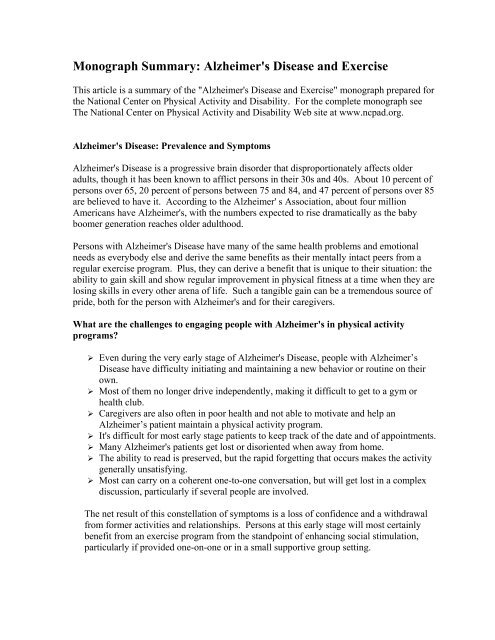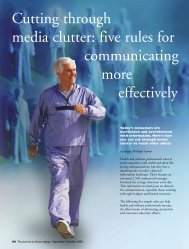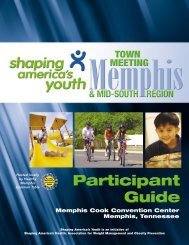Monograph Summary: Alzheimer's Disease and ... - Active for Life
Monograph Summary: Alzheimer's Disease and ... - Active for Life
Monograph Summary: Alzheimer's Disease and ... - Active for Life
Create successful ePaper yourself
Turn your PDF publications into a flip-book with our unique Google optimized e-Paper software.
<strong>Monograph</strong> <strong>Summary</strong>: <strong>Alzheimer's</strong> <strong>Disease</strong> <strong>and</strong> Exercise<br />
This article is a summary of the "<strong>Alzheimer's</strong> <strong>Disease</strong> <strong>and</strong> Exercise" monograph prepared <strong>for</strong><br />
the National Center on Physical Activity <strong>and</strong> Disability. For the complete monograph see<br />
The National Center on Physical Activity <strong>and</strong> Disability Web site at www.ncpad.org.<br />
<strong>Alzheimer's</strong> <strong>Disease</strong>: Prevalence <strong>and</strong> Symptoms<br />
<strong>Alzheimer's</strong> <strong>Disease</strong> is a progressive brain disorder that disproportionately affects older<br />
adults, though it has been known to afflict persons in their 30s <strong>and</strong> 40s. About 10 percent of<br />
persons over 65, 20 percent of persons between 75 <strong>and</strong> 84, <strong>and</strong> 47 percent of persons over 85<br />
are believed to have it. According to the Alzheimer' s Association, about four million<br />
Americans have <strong>Alzheimer's</strong>, with the numbers expected to rise dramatically as the baby<br />
boomer generation reaches older adulthood.<br />
Persons with <strong>Alzheimer's</strong> <strong>Disease</strong> have many of the same health problems <strong>and</strong> emotional<br />
needs as everybody else <strong>and</strong> derive the same benefits as their mentally intact peers from a<br />
regular exercise program. Plus, they can derive a benefit that is unique to their situation: the<br />
ability to gain skill <strong>and</strong> show regular improvement in physical fitness at a time when they are<br />
losing skills in every other arena of life. Such a tangible gain can be a tremendous source of<br />
pride, both <strong>for</strong> the person with <strong>Alzheimer's</strong> <strong>and</strong> <strong>for</strong> their caregivers.<br />
What are the challenges to engaging people with <strong>Alzheimer's</strong> in physical activity<br />
programs?<br />
‣ Even during the very early stage of <strong>Alzheimer's</strong> <strong>Disease</strong>, people with Alzheimer’s<br />
<strong>Disease</strong> have difficulty initiating <strong>and</strong> maintaining a new behavior or routine on their<br />
own.<br />
‣ Most of them no longer drive independently, making it difficult to get to a gym or<br />
health club.<br />
‣ Caregivers are also often in poor health <strong>and</strong> not able to motivate <strong>and</strong> help an<br />
Alzheimer’s patient maintain a physical activity program.<br />
‣ It's difficult <strong>for</strong> most early stage patients to keep track of the date <strong>and</strong> of appointments.<br />
‣ Many <strong>Alzheimer's</strong> patients get lost or disoriented when away from home.<br />
‣ The ability to read is preserved, but the rapid <strong>for</strong>getting that occurs makes the activity<br />
generally unsatisfying.<br />
‣ Most can carry on a coherent one-to-one conversation, but will get lost in a complex<br />
discussion, particularly if several people are involved.<br />
The net result of this constellation of symptoms is a loss of confidence <strong>and</strong> a withdrawal<br />
from <strong>for</strong>mer activities <strong>and</strong> relationships. Persons at this early stage will most certainly<br />
benefit from an exercise program from the st<strong>and</strong>point of enhancing social stimulation,<br />
particularly if provided one-on-one or in a small supportive group setting.
Persons in the moderate stage of <strong>Alzheimer's</strong> <strong>Disease</strong> will experience a worsening of the<br />
above-mentioned symptoms. In addition, they may no longer be able to comprehend or<br />
respond appropriately to conversation directed at them. They may no longer consistently<br />
identify their spouse or children, though they will recognize them as someone close to <strong>and</strong><br />
loved by them. Confusing spouses with long-deceased parents, or children with siblings is<br />
very common. They may become suspicious, accusing a son or daughter-in-law, or longtrusted<br />
household worker of stealing their belongings or their spouse of being unfaithful.<br />
Frustration engendered by their failing abilities may trigger outbreaks of aggressive behavior.<br />
W<strong>and</strong>ering <strong>and</strong> sleep disturbances may occur <strong>and</strong> ability to dress, bathe, shampoo, <strong>and</strong> brush<br />
teeth independently may be lost. There may be occasional incontinence, made more difficult<br />
to manage by patient resistance to wearing absorbent products.<br />
Many persons with moderate <strong>and</strong> moderate-to-severe symptoms remain at home with help<br />
from hired part-time caregivers <strong>and</strong> the use of adult daycare centers. Patients at this level are<br />
excellent c<strong>and</strong>idates <strong>for</strong> an exercise program. If your care recipient attends a daycare center,<br />
insist that he/she include regular exercise in their daily programming. If you have hired help<br />
in the home, require them to take the person <strong>for</strong> brisk walks <strong>and</strong> engage them in regular<br />
exercise.<br />
Persons in the severe stage of dementia are unable to communicate or recognize family<br />
members, may have difficulty swallowing, are incontinent <strong>and</strong> incapable of any self-care<br />
activities, <strong>and</strong> may be bedridden much of the time. They typically do respond to music,<br />
touch, a doll or stuffed animal, the affection of a dog or cat. Any movement they can be<br />
encouraged to make will be beneficial to their cardio respiratory systems <strong>and</strong> reduce the<br />
likelihood of pressure sores <strong>and</strong> other infections.<br />
Where to begin?<br />
‣ Convincing people of the benefits of exercise is an essential first step. Many<br />
persons with early stage Alzheimer’s are worried about becoming a burden to<br />
their families. Explaining that exercise can help keep them healthy <strong>and</strong> make care<br />
giving easier on their loved ones can be a strong selling point.<br />
‣ Obtain a thorough physical exam by a physician, preferably one that believes in<br />
the health benefits of exercise. Such an exam may reveal cardiac,<br />
musculoskeletal, or other problems that may impose restrictions on the type <strong>and</strong><br />
intensity of exercise to be undertaken. If this is the case, request a referral to a<br />
physical therapist or cardiac-rehab specialist to work out a beginning regimen that<br />
is suitable <strong>for</strong> the individual.<br />
‣ Ask the person's physician to rein<strong>for</strong>ce his or her exercise recommendation by<br />
writing out a prescription that can be shown to the individual periodically. Such<br />
an instruction carries more weight than suggestions from a caregiver.<br />
The key to motivating people to persevere in any program of lifestyle change is social<br />
support. Exercise programs <strong>for</strong> persons with disabilities that are successful are all
characterized by the presence of exercise "buddies" or program monitors that provide<br />
ongoing supervision <strong>and</strong> encouragement.<br />
Family <strong>and</strong> close friends of a person with dementia can be the catalyst <strong>for</strong> making an exercise<br />
regimen part of the patient’s. Instead of (or tacked onto) a weekly meal together or a trip to<br />
church or the mall, trips to a fitness center can be planned. If this is not possible, a local high<br />
school or college student might be asked to help out (either as a volunteer or as a hired<br />
assistant). Exercising should be made a social activity.<br />
A balanced exercise program <strong>for</strong> persons with <strong>Alzheimer's</strong> <strong>Disease</strong>, as <strong>for</strong> any population,<br />
should include activities that improve flexibility, balance, cardiovascular endurance (aerobic<br />
activity), <strong>and</strong> strength (weight training).<br />
For people with <strong>Alzheimer's</strong> <strong>Disease</strong> in otherwise good health, a session might start with a 5-<br />
minute walk or a series of stretches, followed by 20 minutes of an aerobic activity, 20-30<br />
minutes of weight training, <strong>and</strong> ending with 5-10 minutes of stretching.<br />
An excellent resource <strong>for</strong> persons who wish to start their care recipient (or themselves) on an<br />
exercise program at home is Exercise: A Guide from the National Institute on Aging. This is<br />
a comprehensive illustrated manual by a panel of experts with an accompanying video that<br />
demonstrates a one-hour workout that includes all four types of exercise cited above. The<br />
manual includes charts <strong>for</strong> recording participants' progress, as well as an order <strong>for</strong>m <strong>for</strong> a free<br />
certificate of achievement <strong>for</strong> persons who follow the program <strong>for</strong> more than one month. The<br />
manual <strong>and</strong> video are available from the National Institute on Aging Public In<strong>for</strong>mation<br />
Office. To order, call 1-800-222-2225.<br />
Set short-term achievable goals, such as a one minute increase in time on the treadmill <strong>and</strong>/or<br />
bike every two weeks until 30 minutes is reached, or steady increases in RPMs, miles per<br />
hour, pounds lifted, or repetitions are achieved. Reward progress along the way - with stars<br />
on a chart, a special T-shirt or badge, or a treat such as a frozen yogurt. Avoid promises of<br />
long-term results, like weight loss, that may not show evidence of progress <strong>for</strong> a long time.<br />
Some activity options:<br />
‣ The easiest, safest, <strong>and</strong> most readily available physical activity <strong>for</strong> a person with<br />
<strong>Alzheimer's</strong> <strong>Disease</strong> is walking. It channels a tendency <strong>for</strong> restlessness <strong>and</strong> w<strong>and</strong>ering<br />
that is characteristic of the disease into a beneficial activity. If possible, combine it with<br />
a purposeful activity, such as walking a dog, pushing a person in a wheelchair, walking to<br />
the store to buy a newspaper or groceries, or picking up trash in the neighborhood. Many<br />
shopping malls have organized "mall walking" programs that offer structure, incentives,<br />
T-shirts, <strong>and</strong> social opportunities, as well as a safe, climate-controlled, stimulating, <strong>and</strong><br />
traffic-free environment. Such programs are a perfect activity <strong>for</strong> an accompanied person<br />
with dementia.<br />
Friends <strong>and</strong> neighbors who know about the <strong>Alzheimer's</strong> diagnosis may be sympathetic<br />
<strong>and</strong> willing to help out, but may not know what to do. Ask several of them to take a
egular turn as a walking partner. Both will benefit. Make sure the person with<br />
<strong>Alzheimer's</strong> <strong>Disease</strong> is wearing a Medic Alert (http://www.medicalert.org/: 1-800-432-<br />
5378) or Safe Return (http://www.alz.org/, 1-800-272-3900) ID bracelet or medallion or<br />
has other identifying in<strong>for</strong>mation on his or her person, in case he or she gets lost when<br />
out walking alone or gets separated from a walking partner. (Many persons with<br />
<strong>Alzheimer's</strong> <strong>Disease</strong> can take unaccompanied walks in their immediate neighborhood in<br />
the early to early moderate stages of the disease; however, it is wise to notify neighbors<br />
along the route <strong>and</strong> the nearest police <strong>and</strong> fire station of the person's diagnosis).<br />
‣ Many communities have hiking clubs that sponsor guided walks at various levels of<br />
difficulty. Universities have hiking <strong>and</strong> service clubs whose members may be willing to<br />
take a person with <strong>Alzheimer's</strong> on an individual or group outing.<br />
‣ A modern day surrey is a four-wheeled canopied vehicle powered by two or more people<br />
pedaling side by side. Steering <strong>and</strong> braking are in the control of one pedaler, though both<br />
have a wheel to hold onto. These vehicles are often available <strong>for</strong> rent at beach resort<br />
towns. However, large bicycle shops may have them <strong>for</strong> sale or rent.<br />
‣ Persons long accustomed to riding a bicycle can continue to do that activity, though it<br />
might be safer <strong>for</strong> him or her to ride on a t<strong>and</strong>em bike with a partner in front. If balance<br />
is a problem, adult tricycles are a stable option that can be enjoyed with a companion on<br />
bike trails or quiet streets.<br />
‣ For couples that already know how to dance, this is an enjoyable activity that can be<br />
continued. Many senior centers hold afternoon or early evening dance parties geared to<br />
the music tastes <strong>and</strong> abilities of older persons. For couples or individuals that don't know<br />
how to dance, certain kinds of dancing (i.e., folk dancing <strong>and</strong> square dancing) can be<br />
enjoyed by a person with dementia, as long as his or her companion can follow the<br />
instructions <strong>and</strong> lead the partner.<br />
‣ Rowing side by side <strong>and</strong> pedaling a two-person pedal boat are enjoyable activities <strong>for</strong><br />
persons with access to such facilities.<br />
‣ Persons with dementia who <strong>for</strong>merly enjoyed gardening will continue to do so, though<br />
they may need supervision to stay on task. Raking leaves is an ideal activity <strong>for</strong> persons<br />
who live in a temperate climate. Using a non-motorized lawnmower is also a good<br />
physical activity.<br />
‣ Household tasks such as sweeping, mopping, running a carpet sweeper or vacuum<br />
cleaner, washing windows, making beds, folding laundry are all over learned tasks that<br />
can be continued with proper supervision.<br />
‣ Volunteer activities can have multiple benefits. They provide physical activity with a<br />
social purpose, which results in improvements in mood <strong>and</strong> self esteem <strong>for</strong> participants.<br />
An added bonus is that the community, often depicting negative images associated with<br />
<strong>Alzheimer's</strong> disease, has an opportunity to see people with this disorder making useful
social contributions. Volunteer activities could include packing food boxes at a local<br />
food bank, bringing pets to a nursing home, taking nursing home residents <strong>for</strong> walks in<br />
their wheelchairs, walking dogs at the Humane Society, picking up trash in public places,<br />
<strong>and</strong> reading to <strong>and</strong> playing with children at a child daycare center.<br />
A "Tried <strong>and</strong> True" Fitness Protocol <strong>for</strong> Persons with <strong>Alzheimer's</strong> <strong>Disease</strong><br />
Each workout should consist of stretching <strong>and</strong> balance exercises, 20-30 minutes of aerobics<br />
(usually achieved by the end of one semester of participation) <strong>and</strong> 20-30 minutes of upper<br />
<strong>and</strong> lower body strength training. (Examples of all the activities administered are available<br />
in the monograph at www.ncpad.org.) The protocol described on the NCPAD Web site has<br />
been successfully used with persons with <strong>Alzheimer's</strong> <strong>Disease</strong> <strong>for</strong> four years at the University<br />
of Arizona Medical Center's cardio-rehab/employee wellness center.<br />
General precautions <strong>and</strong> procedures<br />
‣ As with any exercise program, general precautions of safety procedures must be installed<br />
be<strong>for</strong>e starting the program. During the first session, record the participant's weight <strong>and</strong><br />
resting pulse. Begin all sessions with a resting pulse below 100, the upper limit <strong>for</strong> a<br />
normal resting pulse. (If your partner's resting pulse is consistently more than 100, check<br />
with his or her doctor to determine at what level it is best to begin exercising.)<br />
‣ Observe your partner's gait. If you notice any signs of instability, be extra vigilant when<br />
he or she is moving about.<br />
‣ Use the "talk test." As a rule of thumb, make sure your partner can talk to you<br />
com<strong>for</strong>tably during any exercise. As long as conversation is possible, the danger of overexertion<br />
or fatigue is minimal.<br />
‣ If using machines, establish <strong>and</strong> record seat adjustments <strong>and</strong> starting weight levels during<br />
the first two orientation visits.<br />
‣ Have subjects drink water at regular intervals <strong>and</strong> rest between sets <strong>and</strong> activities. Make<br />
sure that there is a restroom close by since participants who drink extra fluids may<br />
require more frequent trips to the restroom.





